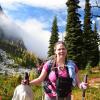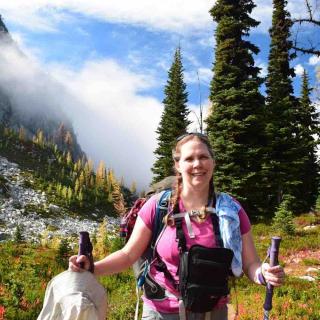 I bent over and looked through the eyepiece of the small telescope and gasped — there was the moon, in sharp detail, every crater edge defined, shadows and light, grey, white and black the only colors. It looked just like a photograph from space. I reluctantly moved away to let my husband have a turn. We were on the shore of Seattle's Green Lake, and had come with our children to a monthly public star party hosted by the Seattle Astronomical Society (SAS).
I bent over and looked through the eyepiece of the small telescope and gasped — there was the moon, in sharp detail, every crater edge defined, shadows and light, grey, white and black the only colors. It looked just like a photograph from space. I reluctantly moved away to let my husband have a turn. We were on the shore of Seattle's Green Lake, and had come with our children to a monthly public star party hosted by the Seattle Astronomical Society (SAS).
For this star party, we had perfectly clear skies and a bright half-moon to our south. (The events are scheduled for the Saturday closest to the first quarter of the moon.) As the skies darkened, the owners of two other telescopes arrived and set up. Mary Anderson is a schoolteacher who enjoys introducing children to the wonders of astronomy. And Mark and his 10-year-old daughter Olivia were here for the first time, setting up Olivia’s brand new telescope that she got from her grandfather. All the telescope owners graciously allowed passers-by to take a peek through their instruments to see the moon and stars up close.
I wasn’t sure what we would be able to see in the middle of the city, but was pleased that we got such a good view of the moon, as well as some stars in the handle of the Big Dipper and other constellations. The teaching was all informal, in response to people's questions and observations. The two more experienced folks (Mary and Peter) were able to expand on what the newbies asked about, and interested Green Lake walkers also stopped by. We had our imaginations and understanding expanded on this evening, and look forward to joining other events in the future.
 Mary got her start by going to the library and checking out every book she could about space. She said it’s been a hobby she could pursue throughout her whole life, and it has brought her much enjoyment. Now she’s the moderator for the SAS discussion forum, Through the Clouds, an online discussion group.
Mary got her start by going to the library and checking out every book she could about space. She said it’s been a hobby she could pursue throughout her whole life, and it has brought her much enjoyment. Now she’s the moderator for the SAS discussion forum, Through the Clouds, an online discussion group.
I asked Mary for some tips for introducing astronomy to children. The first thing she recommended is for the adult to model interest, discovery, and how to learn about what you don’t know. If you don’t have a telescope, you can look at some objects in the sky with binoculars. If you are interested in telescopes, do some research about optics and keep your eyes open for sales and good prices on basic models.
Also, take children out of the city occasionally so they can see what the sky looks like without light pollution. A trip to a location with a really dark sky can awaken a child’s sense of wonder.
If you go . . .
When: Future star parties at Green Lake are scheduled for September 22, October 20, November 17, and December 22, starting at 8 p.m.
Where: They are held at a grassy area southwest of the Bathhouse Theater; get directions and parking information for the Green Lake party at the SAS website. There are also parties on the same evenings at Paramount Park in Shoreline.
Tips: Be sure to check the SAS website on the day of the scheduled visit to make sure it is still happening, since the events can be canceled in the event of cloudy skies. Though summer is the best time for observing because the weather tends to be clearer, Mary notes that "observing conditions are quite unpredictable in Seattle, but an abundance of interesting objects are available through the whole year to the observer who can see them."
- Bring jackets and warm clothes.
- If you would like a flashlight, try to bring one with a red lens to protect your night vision.
- Inexpensive star charts or star wheels (such as these) or even apps for your phone can help you figure out what you are looking at.
Other resources for family astronomy
- The first two weekends this month, The Museum of Flight is holding a workshop on the phases of the moon for parents and kids.
Parents can also take children to the Jacobsen Observatory on the University of Washington campus for star-viewing on first and third Wednesdays, April through October.
- School groups and other children’s clubs (such as Scouts) can also visit the UW Planetarium on Fridays for educational shows.
- The Pacific Science Center's Willard Smith Planetarium hosts multiple shows a day, from a "Preschool Trip to the Moon" to "Star Secrets of the Pyramids," a companion show to the King Tut exhibit.
- The Astronomy magazine website has a wealth of information even if you don’t subscribe, including a section on astronomy for kids. Sky and Telescope is another popular magazine, with a website full of information, including sky charts and news about what to look for in the sky this week.
Photo credits: Top photo, courtesy of daita, Flickr. Second photo by Jennifer Johnson.




